
The Lophophorata or Tentaculata are a Lophotrochozoan clade consisting of the Brachiozoa and the Bryozoa. They have a lophophore. Molecular phylogenetic analyses suggest that lophophorates are protostomes, but on morphological grounds they have been assessed as deuterostomes. Fossil finds of a genus of segmented worm named Wufengella suggest that they evolved from a worm close to annelids.

Jean Guillaume Bruguière was a French physician, zoologist and diplomat.
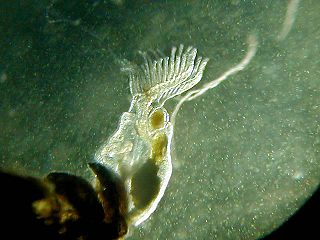
The lophophore is a characteristic feeding organ possessed by four major groups of animals: the Brachiopoda, Bryozoa, Hyolitha, and Phoronida, which collectively constitute the protostome group Lophophorata. All lophophores are found in aquatic organisms.

Lingulata is a class of brachiopods, among the oldest of all brachiopods having existed since the Cambrian period. They are also among the most morphologically conservative of the brachiopods, having lasted from their earliest appearance to the present with very little change in shape. Shells of living specimens found today in the waters around Japan are almost identical to ancient Cambrian fossils.
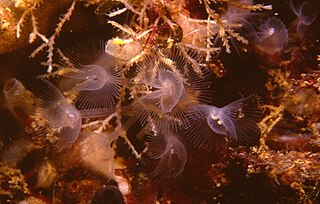
Phoronis is one of the two genera of the horseshoe worm family (Phoronidae), in the phylum Phoronida. The body has two sections, each with its own coelom. There is a specialist feeding structure, the lophophore, which is an extension of the wall of the coelom and is surrounded by tentacles. The gut is U-shaped. The diagnostic feature that distinguishes this genus is the lack of epidermal invagination at the base of the lophophore. These worms are filter feeders. They live on hard substrates or soft sediments in marine environments throughout the world. They have different modes of reproduction which help with their success.

Lingula is Latin for "little tongue". It can stand for:
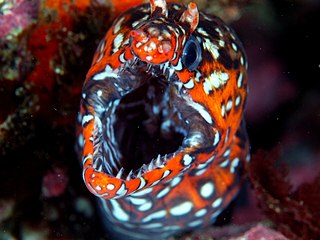
Enchelycore is a genus of moray eels in the family Muraenidae. Enchelycore species are generally small to medium-sized eels, most ranging from 2 to 3 feet in length, with the largest being the Mosaic Moray, which reaches a length of 6 feet (180 cm). Members of the genus feature distinctive, curved jaws that prevent them from fully closing their mouth and aids them in catching, and holding on to prey. Enchelycore species can also feature extremely bright colors and ornate markings.

Anodonta is a genus of freshwater mussels in the family Unionidae, the river mussels.

Lingula is a genus of brachiopods within the class Lingulata. Lingula or forms very close in appearance have existed possibly since the Cambrian. Like its relatives, it has two unadorned organo-phosphatic valves and a long fleshy stalk. Lingula lives in burrows in barren sandy coastal seafloor and feeds by filtering detritus from the water. It can be detected by a short row of three openings through which it takes in water (sides) and expels it again (middle).

The fangtooth moray sometimes also known as tiger moray or bird-eye conger is a moray eel of the family Muraenidae found in warmer parts of the eastern Atlantic Ocean, including the Canary Islands, Madeira and various other islands. It entered the Mediterranean Sea from the Atlantic and is now found occasionally in the eastern Basin, from Levantine waters and off Turkey, Greece, Croatia and Sicily.
Lingula reevii is an inarticulated brachiopod species assigned to the family Lingulidae. L. reevii is rare and is known to occur in shallow, sandy reef flats in Kaneohe Bay, Oahu, Hawaii, as well as in Japan, and Ambon, Indonesia.
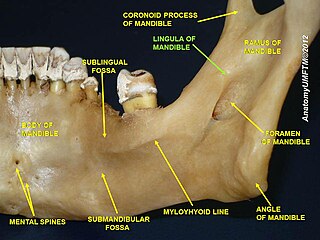
The lingula of the mandible is a prominent bony ridge on the medial side of the mandible. It is next to the mandibular foramen. It gives attachment to the sphenomandibular ligament.

Phoronids are a small phylum of marine animals that filter-feed with a lophophore, and build upright tubes of chitin to support and protect their soft bodies. They live in most of the oceans and seas, including the Arctic Ocean but excluding the Antarctic Ocean, and between the intertidal zone and about 400 meters down. Most adult phoronids are 2 cm long and about 1.5 mm wide, although the largest are 50 cm long.

Brachiopods, phylum Brachiopoda, are a phylum of trochozoan animals that have hard "valves" (shells) on the upper and lower surfaces, unlike the left and right arrangement in bivalve molluscs. Brachiopod valves are hinged at the rear end, while the front can be opened for feeding or closed for protection. Two major categories are traditionally recognized, articulate and inarticulate brachiopods. The word "articulate" is used to describe the tooth-and-groove structures of the valve-hinge which is present in the articulate group, and absent from the inarticulate group. This is the leading diagnostic skeletal feature, by which the two main groups can be readily distinguished as fossils. Articulate brachiopods have toothed hinges and simple, vertically-oriented opening and closing muscles. Conversely, inarticulate brachiopods have weak, untoothed hinges and a more complex system of vertical and oblique (diagonal) muscles used to keep the two valves aligned. In many brachiopods, a stalk-like pedicle projects from an opening near the hinge of one of the valves, known as the pedicle or ventral valve. The pedicle, when present, keeps the animal anchored to the seabed but clear of sediment which would obstruct the opening.
Coenonia is a genus of bacteria. Up to now there is only one species of this genus known: Coenonia anatina.

The cambroernids are an informally-named clade of unusual Paleozoic animals with coiled bodies and filamentous tentacles. They include a number of early to middle Paleozoic genera noted as 'bizarre" or "orphan" taxa, meaning that their affinities with other animals, living or extinct, has long been uncertain. One leading hypothesis is that cambroernids were unusual ambulacrarian deuterostomes, related to echinoderms and hemichordates. Previously some cambroernids were compared to members of the broad invertebrate clade Lophotrochozoa; in particularly they were allied with lophophorates, a subset of lophotrochozoans bearing ciliated tentacles known as lophophores. However, this interpretation has more recently been considered unlikely relative to the deuterostome hypothesis for cambroernid origins.
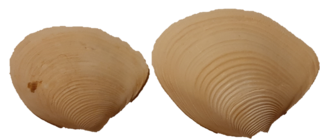
Anatina is a genus of saltwater clams, marine bivalve molluscs in the family Mactridae.
Phoronis ovalis is a species of marine horseshoe worm in the phylum Phoronida. It is found in shallow waters in the northeastern Atlantic Ocean, the southeastern Atlantic Ocean, Argentina, and other scattered locations worldwide. These worms secrete a tube into which they can retreat, and burrow into the shells of molluscs.
The following is a taxonomy of extant (living) Brachiopoda by Emig, Bitner & Álvarez (2019). There are over 400 living species and over 120 living genera of brachiopods classified within 3 classes and 5 orders, listed below. Extinct groups are not listed.















